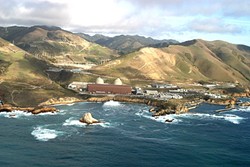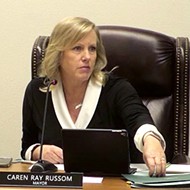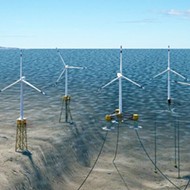[{
"name": "Ad - Medium Rectangle CC01 - 300x250",
"id": "AdMediumRectangleCC01300x250",
"class": "inlineCenter",
"insertPoint": "8",
"component": "2963441",
"requiredCountToDisplay": "12"
},{
"name": "Ad - Medium Rectangle LC01 - 300x250",
"id": "AdMediumRectangleCC01300x250",
"class": "inlineCenter",
"insertPoint": "18",
"component": "2963441",
"requiredCountToDisplay": "22"
},{
"name": "Ad - Medium Rectangle LC09 - 300x250",
"id": "AdMediumRectangleLC09300x250",
"class": "inlineCenter",
"insertPoint": "28",
"component": "3252660",
"requiredCountToDisplay": "32"
}]
When PG&E released a report assessing seismic risks at its Diablo Canyon nuclear power plant in September 2014, the headlines in the press were confident and reassuring.
“Diablo Canyon can withstand earthquake, PG&E study concludes,” the San Luis Obispo Tribune stated. The headline in that week’s New Times echoed a similar sentiment, beginning its headline with the phrase “Solid ground.”
While the headlines reflected confidence in the report, referred to as the California Central Coast Seismic Imaging Project (CCCSIP), recently released internal company emails reveal that a consultant scientist working on the project for PG&E gave it far from ringing endorsements in the months before the research was released to the public and to federal and state regulators.
In a July 15, 2014, email, Dr. Stephen Thompson, a geologist for a consulting company working on the project, offered a less than stellar assessment to one of his superiors.
“Things are going horribly,” Thompson wrote.
At the time, scientists were working on research for the CCCSIP to fulfill requirements of state regulators under Central Coast Assemblyman Sam Blakeslee’s AB 1632 bill and also to satisfy the federal Nuclear Regulatory Commission’s Senior Seismic Hazard Analysis Committee requirements. In the email, Thompson stated that the reports were “in bad shape” and “will be a blight on PG&E if they go out as is.”
The email is just one in a trove of more than 2,400 internal communications from the company obtained by The Alliance For Nuclear Responsibility, a nonprofit watchdog group. Those emails are the basis for testimony submitted in July 2015 by the group’s attorney John Geesman to the California Public Utilities Commission. The group called the study a “seismic whitewash” that squandered millions in ratepayer dollars.
“The CCCSIP was deeply flawed, and PG&E’s seismic consultants raised alarms about this less than two months before it was released,” a press release from the group stated.
In an emailed response to questions from New Times, PG&E spokesman Blair Jones said emails in the filing were evidence of the company’s “extensive scientific effort” to complete the seismic studies. He said that Thompson’s email didn’t reflect on the research being performed, but on the work required to complete that research.
“In the case of the exchange between the two consultants, the emails reflect the fact that one of them was working hard to meet deadlines, and the nature of the work is requiring a substantial amount of time and energy,” Jones said. “The consultant [Thompson] is noting that he is getting pressed to complete multiple projects and that the draft CCCSIP report at that time needed more work. PG&E’s commitment was to provide an accurate and detailed analysis of the advanced seismic studies for regulators, scientists, and the public.”
Despite Thompson’s concerns, PG&E’s release date for the study slipped only slightly from late July 2014 to Sept. 10, 2014, according to Geesman’s testimony The tone of Thompson’s email isn’t reflected in statements made by PG&E officials in the wake of the report’s September release. The confident public statements of PG&E officials bolstered the positive headlines about the study: particularly those from Ed Halpin, senior vice president and chief nuclear officer for PG&E.
“The conclusions are that Diablo Canyon is seismically safe,” Halpin was quoted in a PG&E press release that accompanied the study’s rollout. “These studies are unprecedented and unlike anything that has been done at any other nuclear power plant in the nation and likely the world.”
In an op-ed printed in The Tribune the following day, Halpin again lauded the study.
“These findings reaffirm that [the plant] is constructed to withstand and able to perform key safety functions during and after the largest potential earthquakes that could occur in our region,” he wrote.
In a internal email dated Sept. 2, 2014, to Richard Klimczak, PG&E geosciences department director, just eight days prior to the CCCSIP rollout, Halpin also expresses concerns. Not with the science of the report, but rather how the data could be perceived.
“Rich—as I retread the executive summary section of the report and go to the last page that summarizes old vs. new data assumptions, it seems the majority of the data has worsened and not improved,” Halpin wrote. “The optics look bad.”
Jones said the full context of the email exchange showed that Halpin was doing his job, and challenging the conclusions of the scientists based on the data he was looking at.
“The primary job of a chief nuclear officer is public safety. Ed Halpin was doing his job by challenging his team to explain how they concluded we were safer when optically, i.e. the summary page he was examining, showed some parameters worsening instead of improving,” Jones wrote in the email to New Times. “The answer, as he alluded to, was in the significance weighting of each parameter.”
In his testimony, Geesman stated that Halpin focused most on how the report would be communicated to the public.
SLO County Supervisor Bruce Gibson said he had a similar impression. Gibson is a member of an Independent Peer Review Panel (IPRP) authorized by the California Public Utilities Commission reviewing PG&E’s seismic findings.
“It was my impression that dealings with the IPRP was more driven by their PR people and management than the scientists working on the study,” he said. “The [PR people] were heavily involved in how it was presented.
“Some of the data they released was of poor quality, even after those discussions took place, the data didn’t show anything conclusive yet they drew conclusions from it,” Gibson said.
The panel hoped to get an early look at the report before it was publically released in order to provide feedback, but Gibson and other panel memers didn’t get the massive 1,700-page document until Sept. 10, when it was released publically.
Gibson said he had not read all of Geesman’s testimony, nor all the emails included with it. He didn’t appear to be shocked by what was contained in them.
“It wasn’t completely surprising,” he said.
In his response to New Times, Jones said PG&E would reply in due course to Alliance For Nuclear Responsibility’s filing.
Staff Writer Chris McGuinness can be reached at [email protected], or on twitter at @CWMcGuinness.
Latest in News
Readers also liked…
-

Coast Unified teachers upset over new position's salary and qualifications
Oct 20, 2022 -

SLO police identify alleged driver who hit and killed couple
Dec 22, 2022 -

When the levee breaks: Oceano residents, county officials walk a tightrope of regulations to manage Arroyo Grande Creek, which some say led to the levee's failure in January
May 18, 2023









